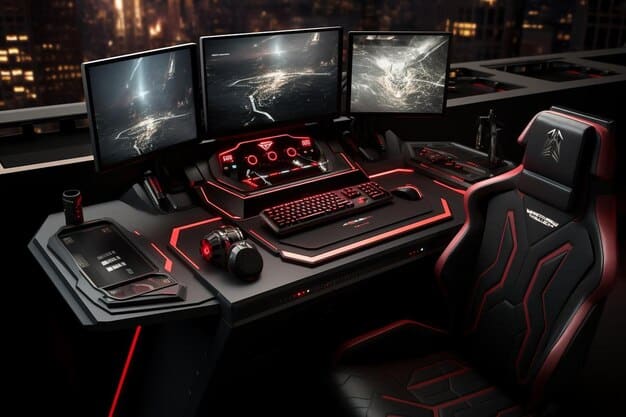Best Esports Gaming Monitors 2025: Data-Driven Review

The landscape of competitive gaming constantly evolves, making the choice of an esports monitor crucial for performance, with 2025 advancing display technology to offer unparalleled advantages in refresh rates, response times, and visual clarity essential for professional players.
In the fiercely competitive world of esports, every millisecond and visual detail can mean the difference between victory and defeat. As technology sprints forward, the demands on gaming hardware escalate. This detailed analysis, “Esports Corner: Comparison/Analysis: The Best Esports Gaming Monitors of 2025 – A Data-Driven Review,” delves into the cutting-edge monitors setting the standard for professional play in 2025, offering insights gleaned from rigorous data and expert evaluation.
The Core Metrics of an Esports Monitor
Understanding what makes an esports monitor truly exceptional goes beyond simply looking at a high refresh rate or low response time. It involves a holistic evaluation of several key technical specifications that collectively contribute to a superior competitive gaming experience. These metrics dictate how fluidly games appear, how quickly player inputs are registered, and how precisely targets can be acquired. Ignoring any one of these can lead to a compromised experience, even if other specifications are top-tier.
Each metric plays a distinct yet interconnected role in performance. For instance, a monitor might boast an incredible refresh rate, but if its response time is slow, ghosting and motion blur can negate the benefits of that high refresh rate. Similarly, superior color accuracy might be appealing for general use, but in the context of competitive esports, it often takes a backseat to raw speed and clarity. The challenge lies in finding a balance that optimizes for the specific needs of professional gaming.
Refresh Rate: The Foundation of Fluidity
The refresh rate, measured in Hertz (Hz), indicates how many times per second a monitor can update its image. For esports, a higher refresh rate is paramount, directly translating to smoother motion and reduced input lag. While 60Hz might be standard for casual use, competitive players demand 144Hz, 240Hz, or even higher, with 360Hz becoming increasingly common in 2025 for top-tier performance. This enables players to perceive enemies and in-game events with greater clarity and react faster, providing a measurable competitive edge.
- 144Hz: Minimum standard for competitive play, offering a noticeable improvement over 60Hz.
- 240Hz: Preferred by many professionals for enhanced fluidity and reduced motion blur.
- 360Hz+: The cutting edge in 2025, providing the ultimate visual smoothness for elite players.
Response Time: Eliminating Motion Blur
Response time refers to how quickly pixels can change from one color to another, typically measured in milliseconds (ms). A lower response time minimizes motion blur and ghosting, ensuring that fast-moving objects appear sharp and clear. For esports, 1ms Grey-to-Grey (GtG) is widely considered the gold standard, though some advanced panels are pushing into sub-1ms territory. This rapid pixel transition is vital for precise aiming and tracking in fast-paced games where every frame matters.
Maintaining a low response time across all color transitions, not just GtG, is important for consistent visual clarity. Manufacturers often highlight their best-case scenarios, but real-world performance can vary. Independent reviews often provide a more accurate picture of a monitor’s true responsiveness, considering factors like overdrive settings and their impact on image quality versus speed.

Panel Technology and Resolution
The type of panel technology significantly impacts a monitor’s overall performance. While IPS panels have traditionally been favored for their superior color accuracy and viewing angles, VA and TN panels offer unique advantages for specific aspects of esports. In 2025, advancements have narrowed the gap, with high-performance IPS panels now capable of rivaling TN for speed, while VA offers deep blacks and high contrast. Resolution also plays a role, with 1080p remaining dominant for competitive play due to its balance of frame rates and visual clarity, though 1440p at higher refresh rates is gaining traction.
TN panels, while often having less vibrant colors and narrower viewing angles, traditionally offered the fastest response times and refresh rates at a more affordable price. However, the latest generation of Fast IPS and IPS Black panels have largely overcome these limitations, offering comparable, if not superior, speed without the typical TN compromises. The choice between 1080p and 1440p often comes down to the game and the player’s system specifications; 1080p ensures maximum frame rates, vital for competitive titles, while 1440p offers a sharper image for those with powerful enough hardware to maintain high frame rates.
Adaptive Sync Technologies: G-Sync vs. FreeSync
Adaptive Sync technologies, namely NVIDIA’s G-Sync and AMD’s FreeSync, are crucial for minimizing screen tearing and stutters, providing a smoother gaming experience. These technologies synchronize the monitor’s refresh rate with the graphics card’s frame rate, eliminating visual artifacts that can distract or hinder competitive performance. While both achieve similar goals, they operate on different principles and are compatible with specific GPU ecosystems.
The choice between G-Sync and FreeSync often depends on the graphics card a player owns. NVIDIA GPUs are fully compatible with G-Sync monitors and increasingly with “G-Sync Compatible” FreeSync monitors, while AMD GPUs leverage FreeSync. Both technologies have matured significantly, offering robust performance, making the decision primarily one of ecosystem compatibility.
NVIDIA G-Sync: Premium Performance
G-Sync monitors incorporate a proprietary hardware module that allows for dynamic refresh rate adjustments. This dedicated hardware ensures a premium, tear-free, and stutter-free experience, often with a tighter control over refresh rate fluctuations. G-Sync Ultimate monitors also include features like HDR support and higher brightness. While typically more expensive, G-Sync is revered for its consistent performance and reliability, especially with NVIDIA GPUs.
- Dedicated Hardware: Ensures optimal synchronization and performance.
- Premium Price: Generally more expensive due to the proprietary module.
- Reliability: Known for consistent and high-quality adaptive sync.
AMD FreeSync: Broad Compatibility
FreeSync, an open-standard technology, leverages the VESA Adaptive Sync standard. This means it doesn’t require a proprietary hardware module, making FreeSync monitors generally more affordable and widely available. FreeSync Premium and Premium Pro tiers offer additional features like low framerate compensation (LFC) and HDR support. FreeSync’s open nature has led to its widespread adoption across the industry, making it a highly accessible and effective solution for combating tearing.
The broad compatibility of FreeSync means that a wider range of monitors support the technology, offering more choice for consumers. While early FreeSync implementations might have had some variance in performance, the technology has matured considerably. With the rise of “G-Sync Compatible” designations by NVIDIA for specific FreeSync monitors, the lines between the two technologies have blurred even further, offering more flexibility for gamers to choose based on their budget and specific preferences rather than strict GPU allegiance.
Ergonomics and Design in Esports Monitors
Beyond raw performance metrics, the physical design and ergonomic adjustability of an esports monitor play a significant role in a player’s comfort, focus, and long-term health during extended gaming sessions. A monitor that allows for easy adjustment of height, tilt, swivel, and pivot can prevent strain and tailor the viewing experience to individual preferences, which is critical in competitive environments where players spend countless hours practicing and competing. These often-overlooked features contribute substantially to the overall user experience.
The aesthetic design also matters, not just for visual appeal but for practicality. A sleek, minimal bezel design can improve multi-monitor setups, while cable management solutions can help keep a professional gaming space tidy and free from distractions. Manufacturers are increasingly recognizing that total immersion and peak performance are not solely about display technology but also about the physical interface with the user.
Adjustability and Stand Quality
A high-quality stand with extensive adjustability is a hallmark of a good esports monitor. The ability to easily adjust height, tilt, swivel, and pivot ensures that a player can maintain an optimal posture and eye level, reducing neck and eye strain. VESA mount compatibility is also important, offering flexibility for mounting the monitor on third-party arms for even more customized positioning.
The stability of the stand is equally critical. In the heat of intense gaming, accidental bumps or movements can distract a player. A sturdy, anti-wobble stand ensures that the monitor remains firmly in place, providing a consistent and stable visual field. Attention to detail in the stand’s design, including robust materials and thoughtful engineering, speaks volumes about the monitor’s overall quality and suitability for competitive use. Investing in a monitor with superior ergonomic features can be as impactful as the display’s technical specifications for sustained performance and well-being.
Connectivity and Features
Modern esports monitors come equipped with a range of connectivity options to support high refresh rates and specialized features. DisplayPort remains the preferred interface for high refresh rate gaming due to its higher bandwidth capabilities, especially for 240Hz and 360Hz displays. HDMI 2.0 or 2.1 ports are also common, providing versatility for connecting consoles or other devices, though HDMI 2.1 is essential for higher resolutions and refresh rates on newer consoles.
Additional features like USB hubs, headphone jacks, and integrated speakers (though less critical for competitive play) add convenience. Many esports monitors also include software enhancements such as crosshairs overlays, black equalizer settings to brighten dark areas, and various game modes optimized for different genres. While these features can be useful, their impact on core competitive performance is often secondary to the fundamental metrics like refresh rate and response time.
Top Esports Monitor Contenders for 2025
As we advance into 2025, the competitive monitor market is brimming with innovation. Manufacturers are pushing the boundaries of refresh rates, response times, and panel technologies to deliver displays that offer a tangible edge to esports professionals. This section highlights some of the leading contenders, chosen based on their performance metrics, reliability, and adoption within the competitive gaming community. These monitors often represent the pinnacle of display engineering, specifically tailored for the demanding nature of professional play.
The selection criteria for these top monitors include not only raw specifications but also the overall user experience, including build quality, ergonomic design, and the effectiveness of adaptive sync technologies. Data-driven comparisons, featuring real-world test results and professional player feedback, underpin these recommendations, moving beyond simple marketing claims to provide a genuinely insightful analysis for anyone serious about competitive gaming.

Dell Alienware AW2524H: The 360Hz Pioneer
The Dell Alienware AW2524H has set a high bar in the 360Hz category, offering an incredibly smooth and responsive experience. Its 24.5-inch Fast IPS panel delivers vibrant colors and wide viewing angles, combined with a blistering 360Hz refresh rate and 1ms GtG response time. It supports NVIDIA G-Sync Ultimate, ensuring tear-free gaming. Its ergonomic stand and premium build quality make it a favorite among professionals seeking the absolute fastest refresh rate available for titles like CS2 and Valorant.
The AW2524H also features excellent motion clarity, crucial for tracking fast-moving targets. Its OSD (On-Screen Display) menu is intuitive, offering a range of customization options for different game types. While its 1080p resolution might seem modest to some, it allows for maximum frame rates, which is precisely what competitive players prioritize. The dedicated G-Sync module ensures a flawless experience, even with fluctuating frame rates, maintaining signal integrity and responsiveness.
ASUS ROG Swift PG27AQN: QHD Competitive Dominance
For those seeking a higher resolution without compromising competitive performance, the ASUS ROG Swift PG27AQN stands out. This 27-inch 1440p monitor boasts a 360Hz refresh rate, a significant achievement for its resolution, and a 1ms GtG response time, powered by a fast IPS panel. It also supports NVIDIA G-Sync, providing a crisp, tear-free image with enhanced detail compared to 1080p monitors. It’s ideal for players who want a sharper image in games like Apex Legends or Warzone, where visual fidelity can aid target acquisition from a distance, without sacrificing speed.
The PG27AQN’s larger screen size and higher resolution cater to a growing segment of competitive gamers who desire more screen real estate and sharper visuals. Despite its higher pixel count, ASUS has managed to maintain an extremely high refresh rate, a testament to advancements in panel technology. Its robust build, extensive connectivity, and features tailored for competitive play, such as its G-Sync processor, solidify its position as a top contender for users with powerful systems capable of driving high frame rates at 1440p.
BenQ ZOWIE XL2566K: The TN Panel Revival
BenQ ZOWIE maintains its strong presence in the esports market with the XL2566K, a monitor optimized for competitive FPS gaming. While many manufacturers are shifting to IPS, the XL2566K embraces a TN panel, leveraging its inherently faster pixel response times to deliver incredibly clear motion, often surpassing IPS alternatives in this specific aspect. It offers a 24.5-inch 1080p display with a 240Hz refresh rate and a sub-1ms response time, focused on minimal ghosting and blur. It might lack the vibrant colors of an IPS, but its DyAc+ technology ensures exceptional motion clarity, highly valued by serious FPS players.
The XL2566K is a testament to BenQ ZOWIE’s commitment to delivering purpose-built esports hardware. Its focus is unequivocally on speed and clarity for first-person shooters, often at the expense of broader visual appeal. The monitor’s ergonomic design, including the S Switch for quick OSD adjustments, and its side shields to minimize distractions, highlight its function-over-form philosophy. The DyAc+ technology is particularly effective at reducing residual blur from fast motion, providing a “pixel-perfect” representation of the game world that many professional players swear by.
Future Trends in Esports Monitor Technology
The evolution of display technology for esports is a relentless pursuit of speed, clarity, and immersion. As we look beyond 2025, several emerging trends promise to redefine what’s possible in competitive gaming monitors. These advancements encompass not only incremental improvements in existing panel technologies but also radical shifts in display types and underlying infrastructure. The goal remains the same: to provide an increasingly seamless and responsive visual experience that virtually eliminates any perceptible lag or artifact between player input and on-screen action.
From the refinement of OLED panels to the potential of even higher refresh rates and the integration of AI-driven display optimizations, the future of esports monitors is poised to deliver unprecedented levels of performance. These innovations will not only push the boundaries for professional players but also trickle down to mainstream gaming, elevating the experience for everyone.
OLED and Mini-LED Advancements
OLED technology, known for its infinite contrast and perfect black levels, is becoming increasingly viable for gaming monitors. While initial OLED panels had concerns about burn-in and traditionally lower brightness, advancements in 2025 are addressing these issues, bringing competitive-grade OLEDs with high refresh rates and lightning-fast response times to the market. Mini-LED backlighting also offers a significant leap for LCD panels, providing superior contrast and local dimming zones that rival OLED without the burn-in concern. These technologies promise a visually stunning and responsive experience.
The maturation of both OLED and Mini-LED technologies means that gamers no longer have to compromise significantly on image quality for competitive performance. OLED’s pixel-perfect response time and individual pixel illumination offer unrivaled clarity for fast motion. Mini-LED, with its precise backlight control, delivers incredible HDR performance and deep blacks, making gaming visuals more impactful while maintaining high refresh rates and low response times. The ongoing development in these areas suggests a future where competitive advantage is paired with breathtaking visuals.
Even Higher Refresh Rates and Adaptive Overdrive
While 360Hz is currently the peak, research and development are ongoing to push refresh rates even higher, with 480Hz and beyond on the horizon. Such extreme refresh rates would demand even faster pixel response times and significant bandwidth from graphics cards. Alongside this, adaptive overdrive technologies are becoming more sophisticated, dynamically adjusting pixel acceleration to minimize ghosting and overshoot artifacts across a wider range of refresh rates, ensuring optimal motion clarity regardless of fluctuating frame rates. This fine-tuning of pixel transitions is crucial for maintaining pristine image quality at hyper-fast speeds.
The pursuit of higher refresh rates isn’t just about raw numbers; it’s about eliminating even the slightest hint of visual lag. At 480Hz, the interval between frames becomes incredibly minute, demanding near-instantaneous pixel transitions. Advanced adaptive overdrive ensures that these transitions are clean, preventing distracting visual trails or inverse ghosting despite the aggressive acceleration. This level of optimization is what truly distinguishes an elite esports monitor for pro-level play.
AI-Enhanced Displays and Connectivity
The integration of Artificial Intelligence (AI) into display processing is an emerging trend that could optimize image quality and response even further. AI algorithms could intelligently upscale resolutions, reduce noise, and even predict motion to minimize latency. Furthermore, the evolution of connectivity standards like DisplayPort 2.1 will provide the necessary bandwidth to support these ultra-high refresh rates at higher resolutions without compression. Wireless display technologies for gaming are also slowly maturing, potentially offering untethered experiences without sacrificing speed, though wired connections will likely remain king for competitive play due to reliability.
AI’s potential in displays goes beyond simple image enhancement. It could potentially optimize the display for specific game genres, learning player preferences and adjusting settings dynamically. For competitive gaming, this could translate into a display that intuitively fine-tunes itself for optimal visibility and responsiveness. DisplayPort 2.1’s massive bandwidth capability ensures that future monitors won’t be bottlenecked by their connection, enabling not just higher refresh rates but also potentially uncompressed 8K gaming and multi-monitor setups with extreme performance requirements.
| Key Metric | Competitive Impact |
|---|---|
| ⚡ Refresh Rate | Higher Hz leads to smoother motion and quicker reaction times. |
| ⏱️ Response Time | Lower ms reduces ghosting and motion blur, ensuring sharp visuals. |
| 🔄 Adaptive Sync | G-Sync/FreeSync eliminate screen tearing and stutter for fluid play. |
| ergonomic Design | Adjustable stands prevent strain and optimize viewing comfort for long sessions. |
Frequently Asked Questions About Esports Monitors
▼
For competitive esports in 2025, a refresh rate of 240Hz is considered the minimum standard for professional play, offering significant fluidity. However, 360Hz monitors are increasingly common among top-tier players and are becoming the new benchmark for ultimate responsiveness and visual smoothness.
▼
A 1ms Grey-to-Grey (GtG) response time is highly recommended for competitive gaming as it minimizes motion blur and ghosting, ensuring that fast-moving objects appear sharp. While not always critical for casual players, it provides a noticeable competitive advantage in fast-paced esports titles where precise aiming and tracking are paramount.
▼
G-Sync (NVIDIA) uses proprietary hardware for adaptive sync, offering premium performance, while FreeSync (AMD) is an open standard, generally more affordable and widely compatible. Your choice primarily depends on your graphics card: NVIDIA GPUs pair best with G-Sync or G-Sync Compatible FreeSync, while AMD GPUs leverage FreeSync.
▼
While curved monitors offer immersion and can be great for casual gaming or productivity, they are generally not preferred for competitive esports. The slight distortion at the edges of the screen can be detrimental in games requiring precise visual information across the entire display, potentially affecting aiming and peripheral awareness in fast-paced scenarios.
▼
For competitive esports, prioritizing refresh rate over resolution is almost always recommended. Higher refresh rates (e.g., 240Hz, 360Hz) provide smoother motion and reduced input lag, offering a direct competitive advantage. While 1440p resolution offers sharper visuals, it often sacrifices frame rates unless you have a top-tier GPU capable of maintaining high FPS.
Conclusion
The journey to selecting the best esports gaming monitor in 2025 is a nuanced one, requiring a deep understanding of core display technologies and a careful consideration of individual competitive needs. As evidenced by the data-driven analysis, success in esports hinges not just on raw talent, but also on optimizing every piece of hardware for peak performance. From the indispensable high refresh rates and lightning-fast response times to the increasingly critical adaptive sync solutions and ergonomic designs, each element contributes to a cohesive, lag-free, and ultimately winning experience. Looking ahead, the rapid advancements in panel technologies like OLED and Mini-LED, coupled with the potential of AI-enhanced displays, promise an even more refined and immersive competitive landscape, ensuring that the relentless pursuit of perfection on screen continues to evolve.





